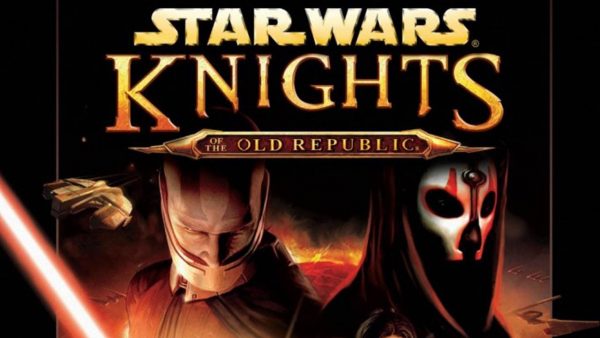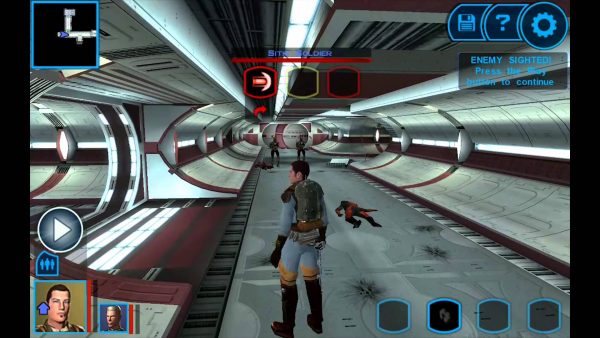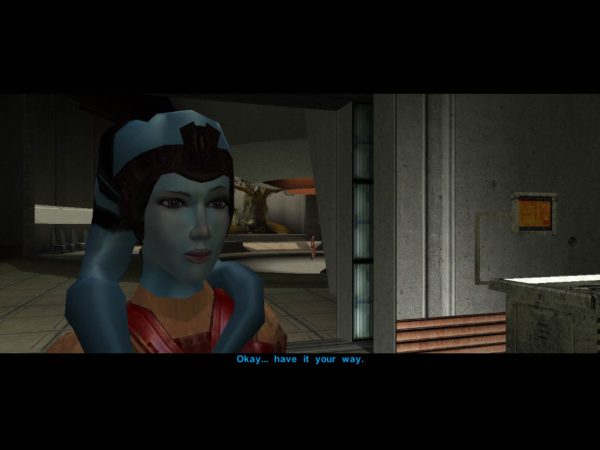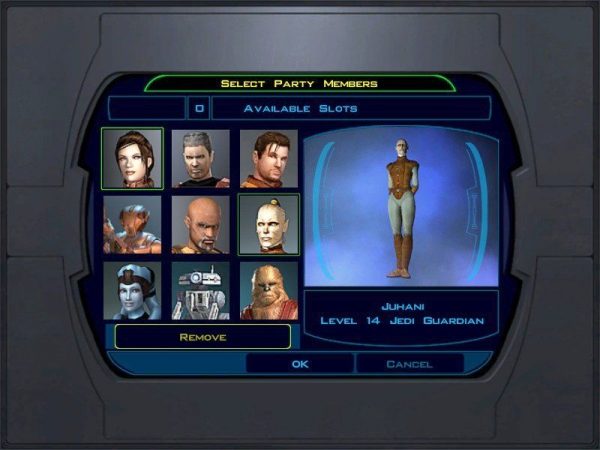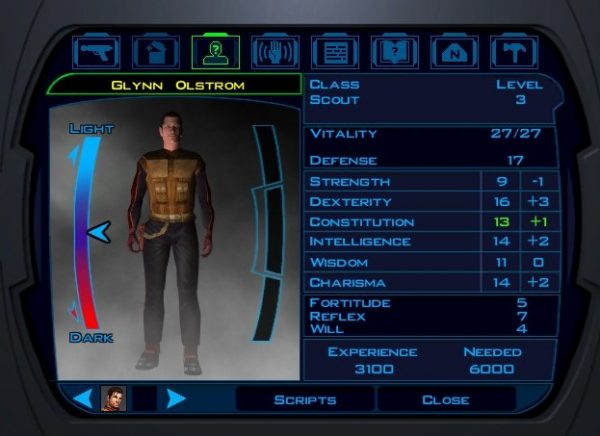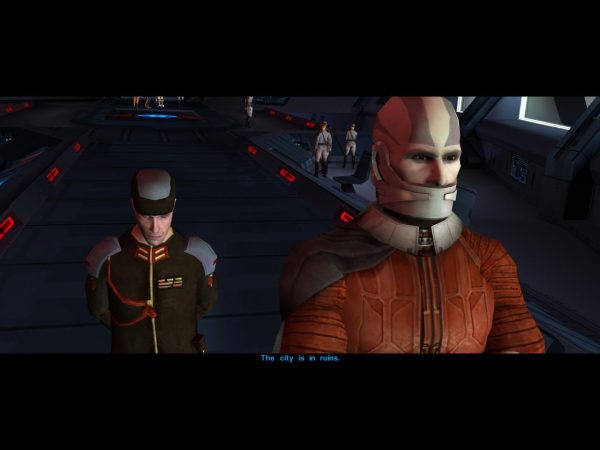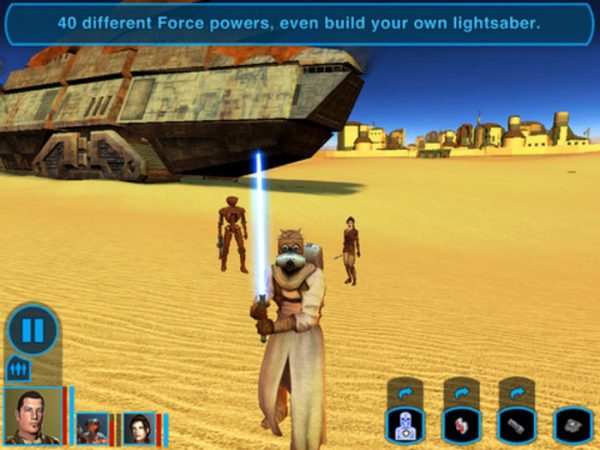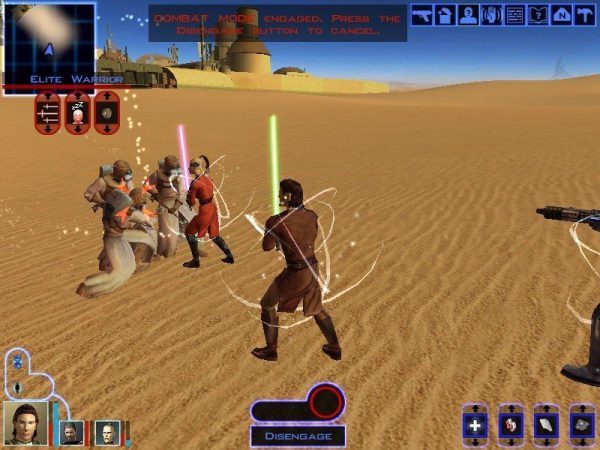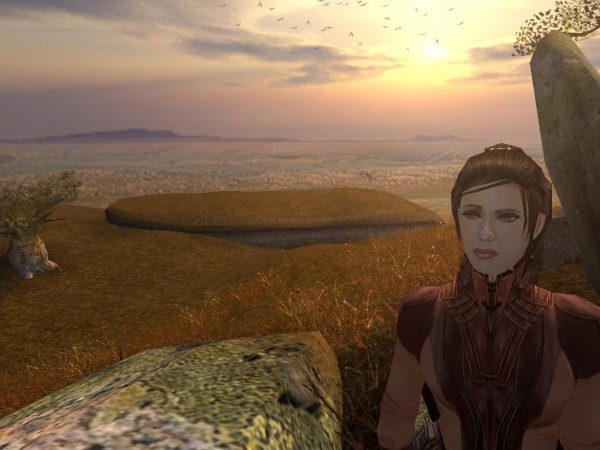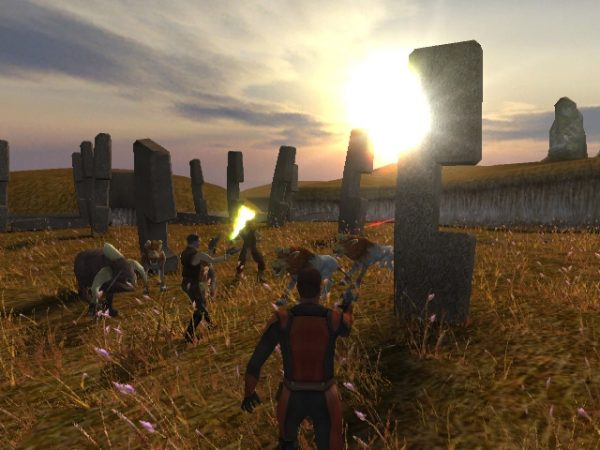Star Wars: Knights of the Old Republic Review
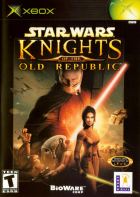

| Game Name: | Star Wars: Knights of the Old Republic |
| Platforms: | Xbox, Windows, Mac OS X, iOS, Android |
| Publisher(s): | LucasArts / EA |
| Developer(s): | BioWare |
| Genre(s): | Role-playing |
| Release Date: | Xbox NA: July 15, 2003 EU: September 12, 2003 Microsoft Windows NA: November 19, 2003 EU: December 5, 2003 (Steam) WW: September 5, 2009 Mac OS X NA: September 7, 2004 (Mac App Store) NA: February 18, 2011 iOS NA: May 30, 2013 Android WW: December 23, 2014 |
| ESRB Rating: | T for: Violence |
Canadian developer BioWare is well known for producing high-quality role-playing games, thanks to its successful Baldur’s Gate series, and offers up what is in many ways its finest such game to date in Star Wars: Knights of the Old Republic. LucasArts wisely delegated the task of producing a deep and involving Star Wars-themed RPG to BioWare, which has done a remarkable job of making Knights live up to the Star Wars name. In fact, Knights arguably lives up to the Star Wars name better than any other Star Wars property in years, including the last two theatrical films. The game’s greatest accomplishment is its focused yet open-ended plot progression, which gives you the freedom to play as either a morally good or evil character, or shades in between. The struggle between good and evil is of course central to Star Wars and manifests itself extremely well throughout this outstanding game. For good measure, Knights features hours and hours of top-notch voice-over (all the dialogue is spoken), so you’ll certainly be impressed by how different characters respond differently to you but also by the sheer size of the game.
https://youtu.be/RmP-_LFTyFo
The gameplay is similar. You create a main character and then explore many different areas, interact with many different characters, settle many different disputes, solve many different puzzles, and engage in plenty of combat. Combat appears to be real-time but actually uses a turn-based system “under the hood” just like Neverwinter Nights, which means your character’s statistics and attributes (and your strategy) make all the difference, and your personal reflexes and hand-eye coordination have no bearing on the outcome. Most importantly, Knights is very different from the typical console RPG in that you’ll always be an active participant in the storyline, rather than a passive observer. You don’t just read, watch, and listen to a lot of text, cutscenes, and dialogue–your character is constantly invited and required to make difficult decisions, and that’s ultimately the most entertaining, impressive, and rewarding aspect of the game.
Knights of the Old Republic actually takes place thousands of years before Star Wars Episode I, though you’ll still see many of the same sorts of alien creatures and technology in the game that you probably associate with Star Wars. The story begins in the midst of a power struggle between the Republic and the Sith, an evil imperial power that’s encroaching on Republic space. Your character seems to be just another Republic trooper, and at the beginning of the game, you manage to avoid certain death as your spaceship is attacked and destroyed. Your escape pod lands on a world that’s been put under quarantine by the Sith, so your first order of business is to find a means of escape, and also to find out what happened to Bastila, a gifted young Jedi who is key to the Republic’s war efforts and who also managed to flee your doomed ship. Later, you’ll be charged with uncovering the secrets of an ancient relic called the star forge, apparently the key to the Sith’s seemingly limitless supply of weaponry.
You’ll end up visiting a number of key Star Wars locations, including the wookiee homeworld of Kashyyyk and the desert planet Tatooine, in what’s by all means an adventure of epic proportions. The game’s main storyline isn’t remarkable and eventually boils down to squaring off against your standard bad guy, and the main plot twists along the way don’t really seem plausible. But you’ll encounter so many great little subplots and characters along the way that this really won’t matter. You’ll investigate murders, become a bounty hunter, resolve cultural disputes, find a cure for a deadly disease, take sides or play both sides against each other in various ambiguous conflicts, and find out how life really treats both citizens of the Republic and followers of the Sith. There’s just a lot to see and do in this game, and it’ll last you a good 40 hours or so from start to finish, yet you’ll never see all that the game has to offer if you finish it only once.
It may seem strange, but Knights of the Old Republic actually uses a slightly simplified version of 3rd Edition Dungeons & Dragons rules both for combat and for character generation. So despite the obviously different setting, fans of BioWare’s D&D-themed games will be in relatively familiar territory here. Your main character starts off as a male or female soldier, scout, or scoundrel. These three basic classes roughly correspond to D&D’s fighter, ranger, and rogue. The soldier is straightforward but very strong and begins with proficiency with various types of weapons and armor and gains the most vitality points per experience level. The scout is slightly less tough than the soldier but gains more skill points per level, allowing him or her to do such things as repair droids, pick locks, and disarm land mines. The scoundrel is physically the weakest class but can disappear from sight using special cloaking devices and can then inflict great damage if he or she catches a foe unaware. The scoundrel is also best suited to talking his or her way out of situations where the other character classes might have to resort to violence. Your choice of gender also has a bearing on some of the situations.
It’s not spoiling anything to point out that you eventually gain access to Jedi powers. In turn, there are three different Jedi classes available, which emphasize either the Jedi’s prowess with a lightsaber or his or her Force powers–or a balance of the two. Force powers are basically like magic spells, allowing you to do such things as stun opponents, knock them down, and choke them, as well as heal yourself and use the Force to persuade characters to see things your way. Some powers are inherently light-inclined, while others are dark-inclined, and though Jedi characters may gain access to any Force power as they gain experience levels, powers that match a Jedi’s moral alignment can be used at a lower cost in Force points (which steadily recharge, allowing you to use your powers continuously).
The game does a fine job of letting you customize your character and his or her companions. Nine different characters will join you over the course of the adventure, and you’ll be able to travel with up to two of them at a time. Most every character has an interesting story to tell that unfolds as you converse with him, her, or it over the course of the game, though some are developed better than others. The most entertaining of the bunch is probably HK-47, who’s like a homicidal and slightly insubordinate C-3PO. As you and the others gain levels, you develop your abilities by choosing from a wide variety of skills (repair, stealth, persuasion, and so on) and combat feats (critical strike, two-weapon fighting, toughness, and so on).
Ultimately, the 3rd Edition rule system works quite well for the game and makes for an experience that seems consistent with the Star Wars mythos, namely that Jedi are extremely powerful, and conventional weapons are practically useless against their lightsabers and their Force powers. However, a few things don’t quite make sense, such as how your strength statistic (as opposed to your dexterity) is tied to your proficiency with a lightsaber, and how ranged weapons generally seem too weak, offering practically no advantages over melee weapons since it’s easy to close the distance with a gun-toting opponent. Also, much like in 3rd Edition D&D, fighter-type characters in Knights of the Old Republic can become overpowered to the point where they’re virtually unstoppable. If you focus on building up such a character, you’ll find that most of the combat in the game will be rather easy at the default difficulty setting, though you can crank it up to make your enemies stronger.
Combat looks dynamic, and at a glance, you could mistake Knights of the Old Republic for an action game. You’ll see characters firing away with their blasters, while those armed with melee weapons such as lightsabers will perform a variety of close-combat moves. Characters dueling with such weapons will block and feint, looking for openings in their opponents’ defenses. It’s all clearly inspired by the dramatic lightsaber battle at the end of Episode I and also resembles the outstanding lightsaber battles in, Jedi Knight II.
Despite appearances, though, the combat is really just a series of statistical checks, just like D&D. Your character’s “to hit” rating, determined by his or her class, level, and weapon, is added to a random 1-20 dice roll and compared against the opponent’s defense rating. If the to-hit roll is greater, you connect and deal damage. Your characters will automatically attack any foes nearby until either you or they are all dead, so in some cases, you end up simply watching the fight unfold. You’ll only need to intervene to use healing kits or stimulants that boost your combat abilities, as well as Force powers and such, or maybe to prioritize targets. You can pause the action at any time and easily queue up specific orders for all your characters, but you can usually get away with just looking after your main character and will rarely need to micromanage things (your party members will lag behind once in a while as you’re running around, but it’s not a big deal). Generally, the combat is exciting to watch and paced nice and fast. You needn’t worry if one of your characters falls in battle–he or she will simply get up once the fighting is over, though you’re tossed back to the title screen if your entire party goes down.
The combat and the dialogue are the two main elements of Knights of the Old Republic. Other than those activities, you’ll find yourself running from place to place, but you’ll have little interaction with the environment other than being able to open footlockers and other objects containing goodies. You can sometimes hack into certain computer systems, but this is all done in text and isn’t very interesting. Loading times between areas can feel a little long, especially when you have to backtrack–fortunately there’s an option to instantly return to your hideout or ship if you’re not in a dangerous area. Some of the environments are pretty big, but most aren’t, and a mapping system clearly shows where you can and can’t go and what the points of interest are in each area. There’s also a very clear record of all the quests you have pending (and all the quests you’ve completed). As such, you’ll probably never get lost in the game, though at the same time, you might feel a bit confined by where you can and can’t go. Fortunately, the game opens up later on, allowing you to freely travel between planets and accomplish numerous tasks in whichever order you please.
The combat and the dialogue are the two main elements of Knights of the Old Republic. Other than those activities, you’ll find yourself running from place to place, but you’ll have little interaction with the environment other than being able to open footlockers and other objects containing goodies. You can sometimes hack into certain computer systems, but this is all done in text and isn’t very interesting. Loading times between areas can feel a little long, especially when you have to backtrack–fortunately there’s an option to instantly return to your hideout or ship if you’re not in a dangerous area. Some of the environments are pretty big, but most aren’t, and a mapping system clearly shows where you can and can’t go and what the points of interest are in each area. There’s also a very clear record of all the quests you have pending (and all the quests you’ve completed). As such, you’ll probably never get lost in the game, though at the same time, you might feel a bit confined by where you can and can’t go. Fortunately, the game opens up later on, allowing you to freely travel between planets and accomplish numerous tasks in whichever order you please.
Knights of the Old Republic also contains several minigames: You can gamble by playing a fairly entertaining card game that’s similar to poker, you can compete in simple drag races on swoop bikes, and you can man the turrets of a spaceship to shoot down enemy fighters from a first-person perspective. These are all simple diversions, however.
As mentioned, character interaction really is the best thing about Knights of the Old Republic. There’s a lot of dialogue in the game, all in full speech, and if you listen to all of it rather than read it (you can turn subtitles off), the game will probably last hours longer than it could otherwise. The dialogue is well done, and many of the game’s characters are well defined. Most all of the numerous subquests in the game are suitably justified and present you with more than one viable solution. You’ll constantly be able to choose between good and not-so-good solutions–early on, for instance, you can rescue a man who’s being hassled by bounty hunters. Do you then offer to pay the dues he owes so that the poor man may live without fear, or do you threaten to mug him for his last remaining credits?
Knights lets you play as a really nasty character if you so choose, and that’s certainly part of the fun. It’s also an interesting aspect of gameplay, considering a big part of the theme is how Jedi constantly run the risk of falling to the dark side–indeed, you’ll probably often be tempted to see what happens if you pick the evil dialogue options rather than the good ones, if only because most RPGs simply don’t let you make these types of decisions. Certain key points in the game will play out very differently depending on the decisions you make, creating lots of replay value.
The graphics in Knights of the Old Republic aren’t the game’s strong suit. Some important aspects of the visuals are handled very well–specifically, the lightsaber combat looks dead-on, though you won’t see any forearms getting chopped off or anything. Effective use of bump mapping and environment mapping can be seen on some of the aliens and their shiny armor or slick, oily skins. Many of the environments also look quite good, though some of the others are plain and lacking in detail. Character models are relatively simple, and their lip-synching and facial expressions don’t always look quite right. You’ll also notice that some character models will repeat often throughout the game–you’ll encounter a number of different characters who all share the same face. The frame rate of Knights of the Old Republic also doesn’t hold up, and it can frequently bog down in combat or whenever a lot of characters are around. Furthermore, the occasional cutscenes using the game’s 3D engine tend to look downright crude, which is disappointing considering how impressive some of the game’s production values are. Knights is a good-looking game overall, but it’s easy to find fault in its visuals when the other aspects of the game are so well done.
Some of the audio is what you’d expect from a Star Wars game, though Knights deserves credit for featuring a mostly original (yet very subdued) soundtrack, which is a nice change of pace from the ubiquitous John Williams score. But the high quality and sheer quantity of the voice acting are exceptional. Alien characters even speak in convincing alien languages, though you’ll pick up on the fact that the alien voice-over actually repeats often. Overall, though, the professional voice cast does an excellent job with the material, delivering believable performances, and this really enriches the gameplay experience. Not only does Knights of the Old Republic have some of the most voice-over of any game to date, but it also has some of the best.
It’s apparent from playing Knights of the Old Republic that a remarkable amount of effort, work, and talent went into this game. It’s one of the only Star Wars games to truly make you feel at times as though you’re a key player in and a part of this unique and beloved sci-fi setting. You’ll get to do all the sorts of stuff that you’ve seen and enjoyed in the Star Wars movies, and you’ll get to emulate any of your favorite characters’ personalities and actions over the course of the game. You’ll also experience a much more morally complex version of Star Wars than what you get from the movies. Along the way, you’ll find a few aspects of the game that you’ll wish were better, but that’s mostly because the vast majority of Knights of the Old Republic is so exceptionally good. You don’t need to be a fan of Star Wars or of RPGs to appreciate all the impressive qualities of this game–but if you are, all the better.



